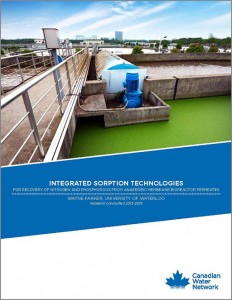Integrated Sorption Technologies for Recovery of Nitrogen and Phosphorous from Anaerobic Membrane Bioreactor Permeates
Principal Investigator - Wayne Parker, Professor, University of Waterloo, 2013 - 2015

Challenge
Municipal wastewaters contain a substantial amount of nitrogen and phosphorous, which, if discharged to water bodies, can cause eutrophication and degradation in surface water quality. Thus, utilities expend considerable resources to remove these substances from wastewaters. On the other hand, nitrogen and phosphorus have a substantial potential value for agriculture and industrial processes as fertilizers and feedstock. Recovery of these nutrients from wastewaters has not been historically practiced, but limited availability of mineral phosphorous and future cost increases in ammonia manufacturing will encourage such procedures.
Technologies currently exist that generate commercially viable fertilizer products from wastewater, but these processes only work in nutrient rich systems — lower concentration waste streams are not directly amenable. However, with high flows, low concentrations represent a substantial amount of lost phosphorus and nitrogen. With this project, researchers propose to capture nutrients in dilute waste streams.
Using sorption-based technologies, this project addresses the recovery of nitrogen and phosphorous from permeates generated when municipal wastewaters are treated in anaerobic membrane bioreactors (AnMBRs). Successful implementation of these technologies will make a substantial contribution towards enhancing the sustainability of wastewater treatment, as it would eliminate the need for energy intensive nitrification processes and the addition of chemicals for phosphorous removal.
Project
The project will focus on the evaluation and development of sorption-based technologies for nitrogen and phosphorus recovery from wastewater streams. The project will be completed in two phases.
In phase one, existing commercial adsorbents will be tested for their applicability. Initial tests will be conducted using clean water to establish equilibrium constants for nitrogen and phosphorus sorption. These samples will be made increasingly more complex with the addition of charged particles, which will help determine the effects of competitive adsorption on nutrient uptake. An ideal sorption-based technology for nutrient recovery would selectively remove the target substance, in this case, nitrogen or phosphorus, to a low final wastewater concentration, while maintaining a high solid mass. In addition, it would be rapidly regenerated using inexpensive regenerants, at which point spent regenerant would be converted into a useful product, like fertilizer. During testing, the regeneration process will be thoroughly examined to identify optimal regenerating conditions, considering such factors as regenerant concentration, composition and time.
In phase two of the project, substances known as nano-structured materials (NSMs), materials made of nanoparticles, will be developed to target ammonium and phosphate. With high surface areas and adjustable properties, NSMs can be engineered to treat specific contaminants in wastewater, allowing researchers to create customizable treatment options in specific environments. In this project, the team will test novel NSMs for the removal of a variety of phosphorus and nitrogen species, including organic species which cannot currently be removed efficiently. NSM properties will be controlled by optimizing several parameters, including pH, stirring rate and reaction time.
Outputs
Anticipated Outputs Include:
- progress updates to be released via biannual newsletters to all funding and in-kind partners.
- Written communication will also include publications in peer reviewed journals or refereed conference proceedings.
- Verbal communication is planned in the form of biannual conference calls, in which current project results will be presented to the partner community. Face-to-face presentations will be facilitated by the annual Gananoque Student Conference of Environmental Science and Engineering.
Outcomes
Anticipated Outcomes:
- Successful development of the proposed technologies would make an important contribution towards increasing the sustainability of wastewater treatment.
- Changes in practice related to the substantial benefits to municipalities due to nitrogen and phosphorous reutilization, less sludge production, and less operating and maintenance costs.
- The results of this study will provide key information for all stakeholders about the technical and economic feasibility of this approach to wastewater treatment.
- Informed decision-making for consultants, municipalities and technology providers regarding this option for nutrient control in wastewater treatment.
The research team will make every effort possible to involve research partners and the end-user community in this research program. To this end the feedback and interactive involvement of end-user and research partners in the specific development is essential.





